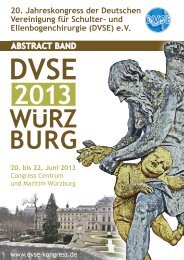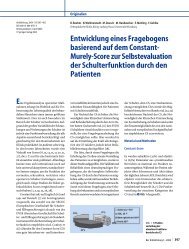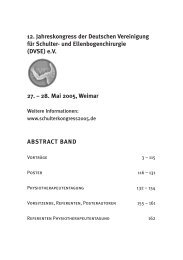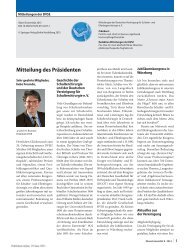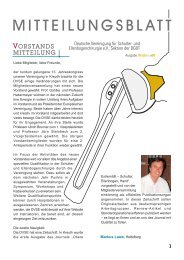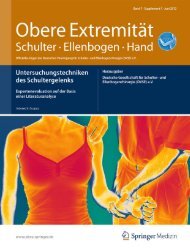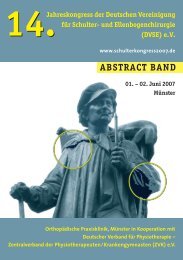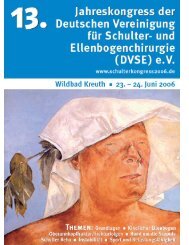Abstractband 17 - DVSE
Abstractband 17 - DVSE
Abstractband 17 - DVSE
Erfolgreiche ePaper selbst erstellen
Machen Sie aus Ihren PDF Publikationen ein blätterbares Flipbook mit unserer einzigartigen Google optimierten e-Paper Software.
Poster, Jahreskongress <strong>DVSE</strong> 2010 – Rosenheim 7. – 8. Mai 2010<br />
P2<br />
Fixation of a Novel Minimally-Cemented, Posteriorly-Augmented<br />
Glenoid Prosthesis<br />
P.H. FLURIN, C. ROCHE; T. WRIGHT, S. GREY, J. STEFFENS, J. ZUCKERMAN –<br />
MERIGNAC<br />
Fragestellung<br />
Glenoid loosening is a common failure mode of total shoulder arthroplasty, particularly in patients with conditions<br />
that could result in compromised initial fi xation. To this end, a novel minimally-cemented glenoid prosthesis<br />
was developed to improve fi xation for patients with posteriorly worn glenoids. This prosthesis is composed<br />
of a 4mm UHMWPE articular bearing surface modularly connected to a grit-blasted Ti-6Al-4V central<br />
bone cage and 3 grit-blasted Ti-6Al-4V peripheral pegs. Initial fi xation is achieved via press-fi t of the Ti-6Al-4V<br />
pegs and PMMA cement on the backside surface of the glenoid. The prosthesis has 8° of posterior build-up to<br />
preserve bone by limiting the amount of eccentric glenoid reaming necessary to correct the patient’s glenoid<br />
version. The fi xation of the proposed device was compared to that of the “gold standard” UHMWPE cemented<br />
glenoid to demonstrate clinical effi cacy.<br />
Methodik<br />
An edge displacement test was conducted according to ASTM F 2028 on a quantity of 6 of the XL posterior<br />
augment cage glenoids; a quantity of 6 of the XL UHMWPE cemented pegged glenoid were used as controls.<br />
Each was implanted in a 30 lb/ft3 polyurethane bone substitute block (Pacifi c Research Laboratories; Vashon,<br />
WA) according to the surgical technique. Each device had a similar radial mismatch when articulated with the<br />
53mm humeral head. The susceptibility to loosening was established by comparing the maximum glenoid<br />
edge displacement before and after cyclic loading (100,000 cycles at 2 Hz) of a 750 N compressive load applied<br />
by a 53 mm humeral head as it was translated along both the superior/inferior and anterior/posterior glenoid<br />
axes. Each glenoid was cyclically loaded in a water-enclosed chamber heated to 37° C. The magnitude of edge<br />
displacement was quantifi ed before and after cyclic loading with an LVDT.<br />
Ergebnisse<br />
The results of this study demonstrate that regardless of the axes tested, no discernable difference in edge displacement<br />
(distraction or compression) occurred before or after cyclic, eccentric loading for either glenoid<br />
design; no difference in compression or distraction was observed between either glenoid design. Additionally,<br />
each glenoid component tested remained fi rmly fi xed after testing; no incidence of dissociation occurred.<br />
Schlussfolgerung<br />
The proposed minimally-cemented, posteriorly-augmented glenoid prosthesis and the traditional “gold standard”<br />
UHMWPE pegged glenoid provide an equal resistance to loosening when subjected to a worst-case cyclic<br />
edge load.<br />
– 105 –



